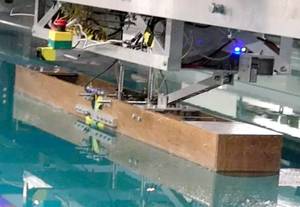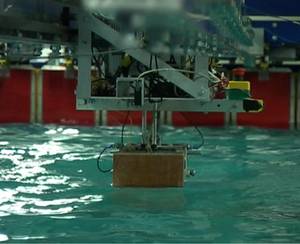Naked Engineering - Modelling Damaged Ships
Interview with
Meera - This week on Naked Engineering, Dave and I are sticking with the theme of shipping, but we're going to look into a few of the basics and see just how ships actually float and what forces are acting on them when they're out at sea. Now Dave firstly, how does a ship float?
Dave - Well water is quite heavy stuff. It weighs about a kilogram for every litre or ton of every cubic metre. This means that the deeper you go, the higher the pressure is. So, the water pressure at the bottom of the ship is going to be a lot higher than the top, which means that overall there's a net force pushing it up and you get this upthrust force which holds up the boat.

Meera - What actually happens then to a boat or a ship out at sea? What sort of forces act on it and how is this overcome to keep it afloat?
Dave - Well there are two major forces. There's the upthrust and gravity. Gravity pulls it down and some bits of the ship are heavier than others so they're going to have more gravity associated with them. And other places are going to have more upthrust than weight so they're like being lifted up. The actual structural design of the ship is all about transferring the forces from the upthrust to where all the weight is, to hold everything up and keep it nice and stable. Even actually with the ship just lying in the sea in perfect calm waters, there are quite big stresses in it, you've got heavy engines in one place, and also the bow and stern at the end of the ship sink downwards which is called hogging.
Meera - These forces are obviously important to understand, but especially on a damaged ship to see just what might happen if a ship were damaged out at sea. So to find out a bit more about this, we've come along to the fluids laboratory at University College London to meet Daniel Fone, who looks into just this.
Daniel - I'm looking into damaged ships and more specifically, damaged ships in waves. The majority of the research that's been done is on a ship in still water.
Dave - And I guess waves put a very large stress on the ship and if you have a damaged ship, the time you're really, really worried is if you were in the middle of the big storm.
Daniel - Precisely and when a ship is damaged, it's got less structure to withstand that stress.
Meera - Well we've come along to your lab to see where you actually conduct your research. There's a gigantic water tank in front of us. It's 20 meters long, 2 ½ meters wide. It's filled with water, about a meter deep, with a model of a ship just floating along in the middle.
Daniel - This tank has two capabilities. Firstly, it has a wave maker at one end which can generate really accurate deepwater waves and the second is there's a towing rail which expands the length of the tank. We can attach models to it.

Meera - And so, in the middle of this tank you have a 2-meter model of a ship, but it's kind of pieced together. What's going on here? What are you actually looking into on this ship?
Daniel - So we call this experiment, the hinged ship experiment. We've taken our 2-metre long model, cut it completely in half, and then hinged the 2 halves back together. We've also positioned load cells which are little devices that can measure a force experienced as a result of waves passing the model. The most critical model of a ship, even when it's not damaged is when it bends longitudinally. So as Dave has previously mentioned, a ship tends to bend along its length so the front and back, or bow and stern, dip into the water if there's less buoyancy or they can come out of the water more than the middle, and so you get a bending effect on the ship. And this is what our experiment is principally set up to capture and we want to know the effect of damage; its location, the size of the hole, on that force.
Meera - So what kind of damage are you actually inducing then?
Daniel - Well this model is made out of PVC and plywood, and the good thing about that is we can easily drill holes in the bottom of it, and then patch them up so we can move the damage around as and when we please, almost. The way that this experiment is set up, we're looking at symmetrical damage, symmetrical about the centre line of the model which is a good simplistic representation of a ship being grounded. If you think about the number of variables there are to consider when a shipor boat gets damaged: the size of the damage, the shape of the hole, the roughness of the hole, where it is along the length of the ship, whether it's at the kind of waterline on one side or whether it's along the bottom; and the compartment that it's damaging, is it full of equipment and machinery, or is it an empty cargo tank? All of these things have quite a significant impact on the forces that are going to result from the damage.

Meera - So we have got this giant water tank in front of us. Could we see this in action?
Daniel - Of course. So I'm going to make a variety of different wavelengths and we have a screen here which will give us readings for the forces in the middle of the ship and also, the motion of the front and end. We've instructed the wave maker in this case to generate what's known as regular waves, so sinusoidal in nature.
Dave - So you've got a nice string of waves with a wavelength of about a metre.
Meera - And now, looking at the screen, showing all the forces acting on the ship then, what's happening to the model of the ship?
Daniel - So the model is being excited by these passing waves and we have sensors positioned to measure displacement at the front and the back. We also have our load cells that we previously talked about, giving out readings of a force, and we have a series of wave probes which measure the displacement of the water, wherever they're mounted. So the model here is exhibiting bending, as can be seen by the screen. It's also obviously moving up and down as the waves go past and the water inside is moving up and down, relative to the model as well.
Dave - I've been having a look at the screen and it seems to be using quite arbitrary units of force, but at the moment, the force seems about 0.3 units peak to peak.
Meera - Okay and Dan, you're now changing the wavelength and making it slightly longer.
Daniel - So I've now reduced the frequency of the wave. Meaning that the wavelength will be longer and we're going to see what happens when the wavelength is exactly the same as the ship length.
Meera - The forces have all seemed to change on the actual graphical screen...
Daniel - Well the waves that we have passing the model now are where their length is equal to the length of the model. And this, in kind of classical ship theory, is known to be the worst case of bending on a ship. These waves, if you were to freeze them as they were passing the model, you would find that, because they're of the same length as the ship, you'd have a peak at either end, and a trough in the middle.
Meera - Which means there's no support in the middle.
Daniel - Exactly. There's no buoyancy in the middle, but there's a maximum buoyancy at either end so the model will bend.
Meera - Okay so, we've seen that there are clear differences when there are different wavelengths in different kind of factors affecting a ship. What have you managed to find to-date, Daniel?
Daniel -Well a lot of software at the moment that model ships that are damaged, generally don't take account to the fact that there's a hole in the ship. They fill a tank full of water, but don't have any hole in it. We simulated the same scenario with our model and we also then compared it with the case where there's a hole in the same compartment, and we found that the behaviour of the fluid inside the model was incredibly different. The case without a hole results in very violent flood water motion, whereas the same scenario with a hole in it, there's a very well-behaved flood water motion. The fact that there's actually a hole there has a kind of damping effect.
Meera - How can all of these be used to actually help captains when they're out at sea with a damaged ship?
Daniel - Well ourselves and the University of Southampton are developing a series of computer tools that can model a ship that's damaged in waves. And these experiments are principally being carried out to validate any results that their and our software are producing. And this software we hope in the future will be able to assist captains out at sea when they get into an emergency response scenario when they report what kind of damage has occurred. We're hoping our software will be able to tell the captain whether he should stay put, given the weather forecast, whether he can make it back under his own steam to a safe haven, whether he needs to be towed, whether to completely jump ship, get out of there because it's going to break in half.
- Previous Planet Earth Online - Fossil Forests
- Next Sustainable Shipping










Comments
Add a comment